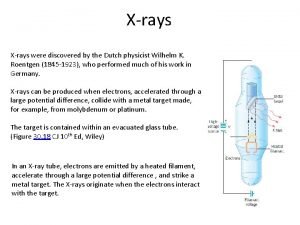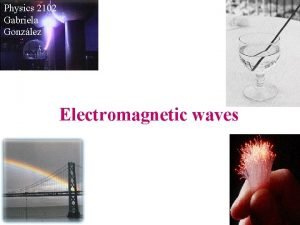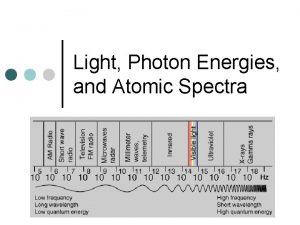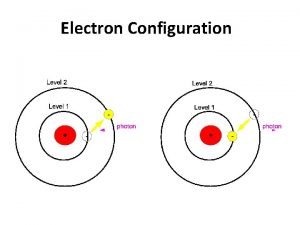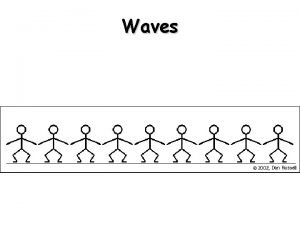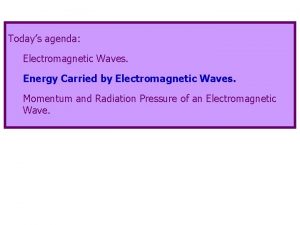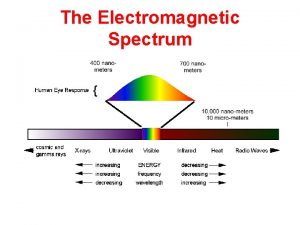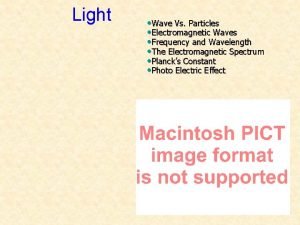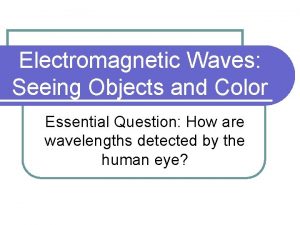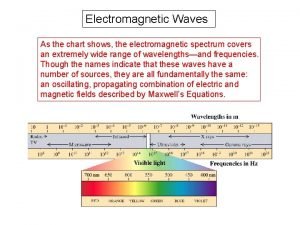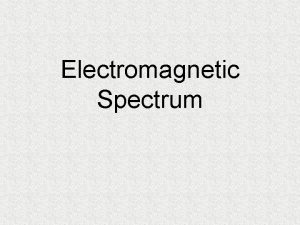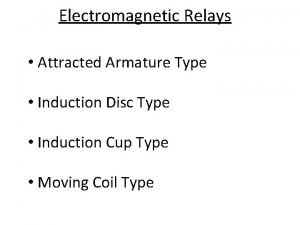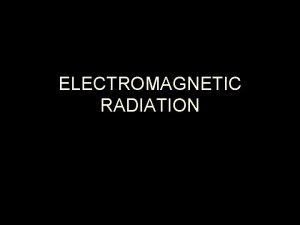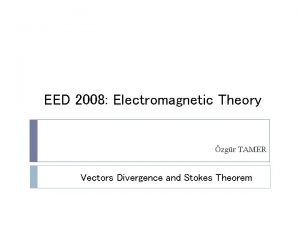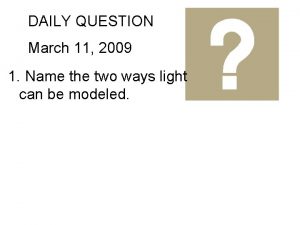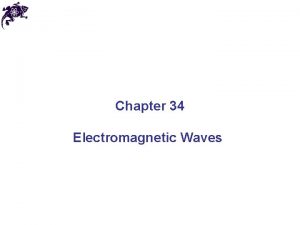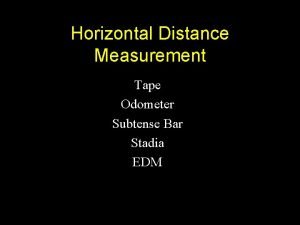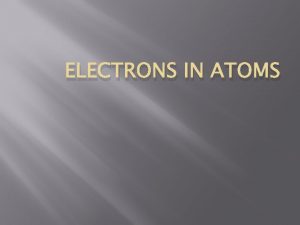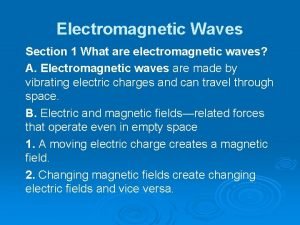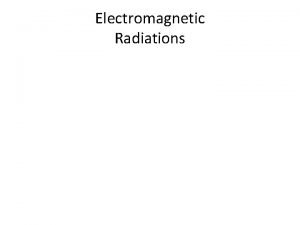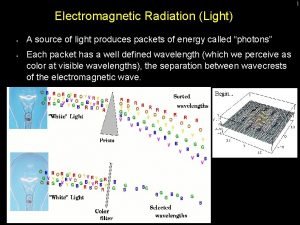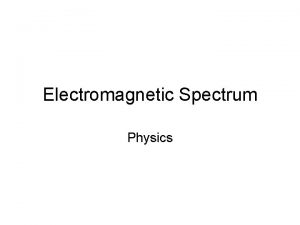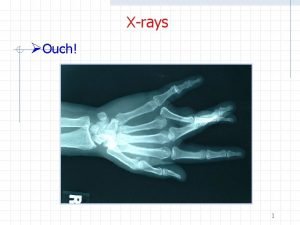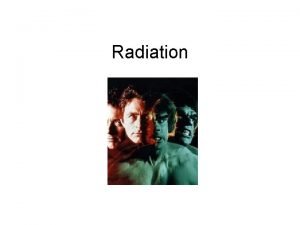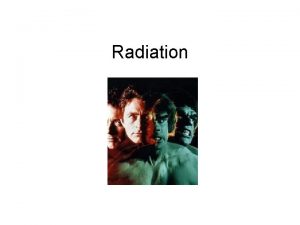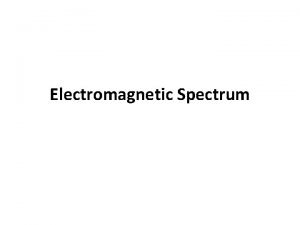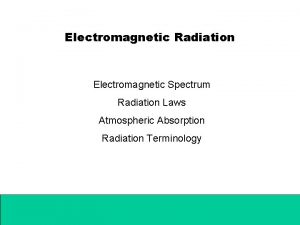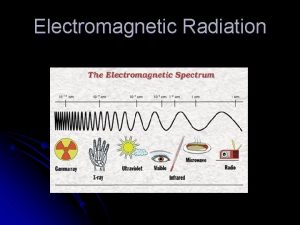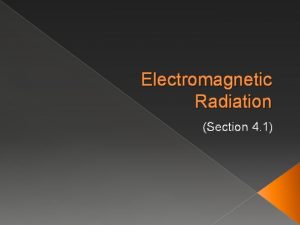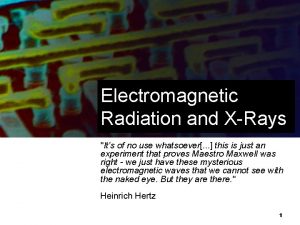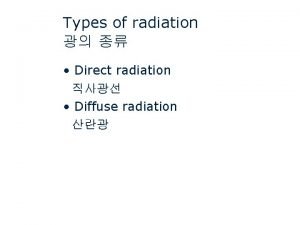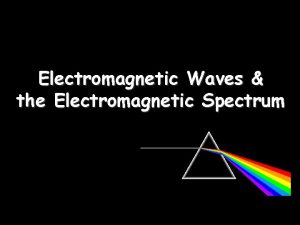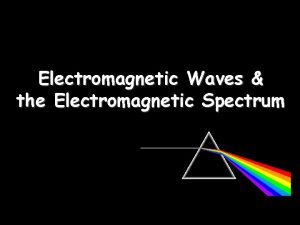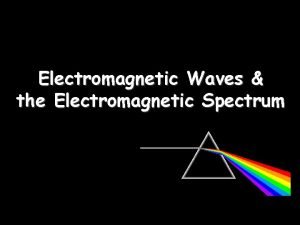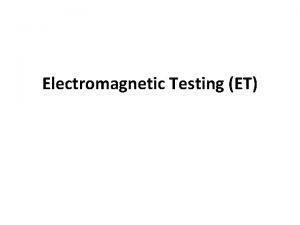XRAYS INTRODUCTION Xrays are types of electromagnetic radiation






![◦ "Because the electrons are relativistic [or moving at near lightspeed], when they give ◦ "Because the electrons are relativistic [or moving at near lightspeed], when they give](https://slidetodoc.com/presentation_image_h2/4e6ed8f5b189c964a78ade827e610feb/image-7.jpg)



























































- Slides: 66

X-RAYS

INTRODUCTION. ◦ X-rays are types of electromagnetic radiation probably most well-known for their ability to see through a person' s skin and reveal images of the bones beneath it. Advances in technology have led to more powerful and focused X-ray beams as well as ever greater applications of these light waves, from imaging biological cells and structural components of materials like cement to killing cancer cells.

TYPES ◦ X-rays are roughly classified into soft X-rays and hard X-rays. Soft Xrays have relatively short wavelengths of about 10 nanometers (a nanometer is one-billionth of a meter), and so they fall in the range of the electromagnetic (EM) spectrum between ultraviolet (UV) light and gamma-rays. Hard X-rays have wavelengths of about 100 picometers (a picometer is one-trillionth of a meter). These electromagnetic waves occupy the same region of the EM spectrum as gamma-rays. The only difference between them is their source: X-rays are produced by accelerating electrons, whereas gamma-rays are produced by atomic nuclei in one of four nuclear reactions.

HISTORY ◦ X-rays were discovered in 1895 by Wilhelm Conrad Röentgen, a professor at Würzburg University in Germany. According to the Nondestructive Resource Center' s "History of Radiography, " Röentgen noticed crystals near a high-voltage cathode-ray tube exhibiting a fluorescent glow, even when he shielded them with dark paper. Some form of energy was being produced by the tube that was penetrating the paper and causing the crystals to glow. Röentgen called the unknown energy "X-radiation. " For this discovery, Röentgen was awarded the very first Nobel Prize in physics, in 1901.

SOURCES AND THEIR EFFECTS. ◦ X-rays can be produced on Earth by sending a high-energy beam of electrons smashing into an atom like copper or gallium, according to Kelly Gaffney, director of the Stanford Synchrotron Radiation Lightsource. When the beam hits the atom, the electrons in the inner shell, called the s-shell, get jostled, and sometimes flung out of their orbit. Without that electron, or electrons, the atom becomes unstable, and so for the atom to "relax" or go back to equilibrium, Gaffney said, an electron in the so-called 1 p shell drops in to fill the gap. The result? An X-ray gets released.

◦ Synchrotron radiation was seen for the first time at General Electric in the United States in 1947, according to the European Synchrotron Radiation Facility. This radiation was considered a nuisance because it caused the particles to lose energy, but it was later recognized in the 1960 s as light with exceptional properties that overcame the shortcomings of Xray tubes.
![Because the electrons are relativistic or moving at near lightspeed when they give ◦ "Because the electrons are relativistic [or moving at near lightspeed], when they give](https://slidetodoc.com/presentation_image_h2/4e6ed8f5b189c964a78ade827e610feb/image-7.jpg)
◦ "Because the electrons are relativistic [or moving at near lightspeed], when they give off light, it ends up being focused in the forward direction, " Gaffney said. "This means you get not just the right color of light X-rays and not just a lot of them because you have a lot of electrons stored, they' re also preferentially emitted in the forward direction. "

X-RAY IMAGING ◦ Due to their ability to penetrate certain materials, X-rays are used for several nondestructive evaluation and testing applications, particularly for identifying flaws or cracks in structural components. According to the NDT Resource Center, "Radiation is directed through a part and onto [a] film or other detector. The resulting shadowgraph shows the internal features" and whether the part is sound. This is the same technique used in doctors' and dentists' offices to create X-ray images of bones and teeth, respectively

◦ X-rays are also essential for transportation security inspections of cargo, luggage and passengers. Electronic imaging detectors allow for real-time visualization of the content of packages and other passenger items. The original use of X-rays was for imaging bones, which were easily distinguishable from soft tissues on the film that was available at that time. However, more accurate focusing systems and more sensitive detection methods, such as improved photographic films and electronic imaging sensors, have made it possible to distinguish increasingly fine detail and subtle differences in tissue density, while using much lower exposure levels.

◦ Additionally, computed tomography (CT) combines multiple X -ray images into a 3 D model of a region of interest. Similar to CT, synchrotron tomography can reveal threedimensional images of interior structures of objects like engineering components, according to the Helmholtz Center for Materials and Energy.

X-RAY THERAPY ◦ Radiation therapy uses high-energy radiation to kill cancer cells by damaging their DNA. Since the treatment can also damage normal cells, the National Cancer Institute recommends that treatment be carefully planned to minimize side effects.

ULTRASONOGRAPHY

contents ◦ Introduction ◦ Principle ◦ Uses ◦ Echocardiography ◦ Imaging Tests of the Liver and Gallbladder ◦ Imaging Tests of the Urinary Tract ◦ Advantages ◦ Disadvantages ◦ Ultrasonographic image of fetus ◦ 3 D Imaging technology ◦ Ultrasound frequencies

introduction

introduction ◦ Ultrasonography uses high-frequency sound (ultrasound) waves to produce images of internal organs and other tissues. A device called a transducer converts electrical current into sound waves, which are sent into the body’s tissues. Sound waves bounce off structures in the body and are reflected back to the transducer, which converts the waves into electrical signals. A computer converts the pattern of electrical signals into an image, which is displayed on a monitor and recorded as a digital computer image. No x-rays are used, so there is no radiation exposure during an ultrasonography.

Principle

uses Ultrasonography is effectively used to image internal organs in the abdomen, pelvis, and chest. However, because sound waves are blocked by gas (for example, in the lungs or intestine) and by bone, ultrasonography of internal organs requires special skills. People who have been specifically trained to do ultrasound examinations are called sonographers. ◦ Gallbladder and biliary tract: For example, to detect gallstones and blockages in the bile ducts

uses ◦ Liver, spleen, and pancreas: For example, to detect tumors and other disorders ◦ Urinary tract: For example, to distinguish benign cysts from solid masses (which may be cancer) in the kidneys or to detect blockages such as stones or other structural abnormalities in the kidneys, ureters, or bladder ◦ Female reproductive organs: For example, to detect tumors and inflammation in the ovaries, fallopian tubes, or uterus ◦ Pregnancy: For example, to evaluate the growth and development of the fetus and to detect abnormalities of the placenta (such as a misplaced placenta, called placenta previa)

uses ◦ Heart: For example, to detect abnormalities in the way the heart beats, structural abnormalities such as defective heart valves, and abnormal enlargement of the heart’s chambers or walls (ultrasonography of the heart is called echocardiography) ◦ Blood vessels: For example, to detect dilated and narrowed blood vessels

Echocardiography ◦ Echocardiography can be used to detect whether the heart muscle is moving normally and how much blood the heart is pumping out with each beat. This procedure can also detect abnormalities in the heart's structure, such as defective heart valves, birth defects (such as holes in the walls between the heart's chambers), and enlargement of the heart's walls or chambers, as occurs in people with high blood pressure, heart failure, or impairment of the heart's muscular walls (cardiomyopathy).

Imaging Tests of the Liver and Gallbladder ◦ Ultrasonography uses sound waves to provide images of the liver, gallbladder, and bile ducts. ◦ ultrasonography is better for detecting structural abnormalities affecting just certain parts of the liver, such as tumors, than for abnormalities that affect the entire liver uniformly, such as cirrhosis (severe scarring of the liver) or fatty liver (excess fat in the liver). It is the least expensive and safest technique for creating images of the gallbladder and bile ducts.

Imaging Tests of the Liver and Gallbladder ◦ can readily detect gallstones in the gallbladder. Ultrasonography of the abdomen can distinguish whether jaundice (a yellowish discoloration of the skin and the whites of the eyes) is caused by obstructed bile ducts or by malfunctioning liver cells. If ultrasonography shows bile ducts that are dilated (widened), the cause is typically obstruction.

Imaging Tests of the Urinary Tract ◦ Ultrasonography is commonly used to obtain images of urinary tract stones and swellings and masses (lumps) in the urinary tract, such as in the kidneys, bladder, scrotum and testes, penis, and urethra. Ultrasonography can also be used to look for blockages in the kidneys or bladder

Ultrasound frequencies ◦ 2. 5 MHz: deep abdomen, obstetric and gynaecological imaging ◦ 3. 5 MHz: general abdomen, obstetric and gynaecological imaging ◦ 5. 0 MHz: vascular, breast, pelvic imaging ◦ 7. 5 MHz: breast, thyroid ◦ 10. 0 MHz: breast, thyroid, superficial veins, superficial masses, musculoskeletal imaging. ◦ 15. 0 MHz: superficial structures, musculoskeletal imaging.

advantages ◦ They are generally painless and do not require needles, shots or cuts. ◦ Patients aren't exposed to ionizing radiation, making the procedure safer than diagnostic techniques such as X-rays and CT scans. In fact, there are no known harmful effects when used as directed by your health care provider. ◦ Ultrasound captures images of soft tissues that don't show up well on X-rays. ◦ Ultrasounds are widely accessible and less expensive than other methods.

disavantages ◦ Insertion of the transducer into the body may cause some discomfort. Rarely, when a transducer is inserted, tissue is damaged, causing bleeding or infection. ◦ Bone or gas can block ultrasonography. Thus, using it to obtain images of certain structures (those behind bone or gas) is difficult.

Ultrasonographic image of fetus

BLOOD COLLECTION by DIFFERENT SPECIES

Terms: Anticoagulants are medicines that help prevent blood clots. (Heparin) Clot normally takes about 25 to 30 seconds. It may take longer if you take blood thinners. plasma The colourless fluid part of blood which contains clotting factors as well as other proteins, glucose etc.

SAFTY PRECAUTIONS : q Have the blood taken by a well trained and experienced phlebotomist. q Make sure they wash their hands and use alcohol gel q They should wear gloves, which is mainly for their protection, but they may identify the vein without gloves, which is safe if their hands are clean. q Make sure they use a clean, freshly unwrapped needle and if using a vacutainer, use a fresh needle holder. They will use fresh items if this is done by a safe practitioner.

Why Blood Collection is to be Done? ? A blood culture is a test that checks foreign invaders like bacteria, yeast, and other microorganisms in your blood. Having these pathogens in your bloodstream can be a sign of a blood infection, a condition known as bacteremia. A positive blood culture means that you have bacteria in your blood.

General Blood Tests q Cholesterol and lipid tests q Blood glucose test q Calcium blood test q The D-dimer test is a blood test used to help check for or monitor blood clotting problems. q ESR test ( Erythrosits sedimentation rate) q INR test An international normalised ratio (INR) test measures the time taken for your blood to clot. q ELISA test

An enzyme-linked immunosorbent assay, also called ELISA or EIA, is a test that detects and measures antibodies in your blood. This test can be used to determine if you have antibodies related to certain infectious conditions.

BLOOD TESTS FOR GOATS Caprine Arthritis Encephalitis (CAE) is a member of the small ruminant lentiviruses which may lead to chronic disease of the joints. Not all goats that become infected will develop clinic disease, therefore it is important to test goats routinely for infection. Johne's Tests Bio. PRYN Blood Pregnancy Test

Sheep Testing 1. Bio. PRYN Blood Pregnancy Test 2. Johne's Disease Tests 3. Glucose A doe can be tested for pregnancy at 30 days or later post breeding or buck removal.

BLOOD TESTS FOR CATTLE 1. BOVINE LEUKOSIS 2. BIO-PRYN PREGNANCY TEST 3. Thalaria 4. Babasia Ticks mites

BLOOD TESTS FOR HORSE 1. Red Blood-Cell Count (RBC) (((4. 2 to 5. 4 million/u. L))) 2. White Blood-Cell Count (WBC) ((4, 500 to 11, 000 WBC /u. L )) 3. Fibrinogen Normal range 1. 5 4. Blood Urea Nitrogen (BUN) 5. Glucose to 3. 5 g/L,

BLOOD TESTS FOR DOG 1. Electrolytes 2. Glucose 3. Blood Urea Nitrogen (BUN) 4. Heartworm Test

BLOOD TESTS FOR CAT 1. BUN 2. Glucose 3. Electrolytes 4. T 4 Thyroxine (T 4) is usually monitored in cats as they get older. A high T 4 might indicate the development of hyperthyroidism, a commonly diagnosed condition in cats, including increased appetite, weight loss, eating non-food items or wanting more human food, and increased vomiting.

CBC or HB test A CBC, or complete blood count, Red blood cell (RBC) counts, RBCs carry oxygen, iron, and other nutrients around the body. White blood cell (WBC) counts, . WBCs help fight inflammation, infection, cancer cells, and parasitic intruders. Platelet counts. Platelets control blood clotting.

CHICKENS Blood is collected from chickens for two purposes: 1. To obtain serum which will be tested for Newcastle disease virus antibodies, 2. To obtain red blood cells, the blood is collected into anticoagulant.

TECHNIQUE : v Handle the chickens gently. v Collect the blood samples quickly. v Take care not to damage the vein. Damaged veins will result in haematomas being formed. v Minimize the loss of blood. This minimizes trauma to the chickens and stress to their owners.

CATTLE : From coccygeal vein of the tail-head, Ø Jugular vein of the neck. Ø Methods : v With the classic needle and syringe, and exiting the contents of the syringe into a vaccutainer tube, v with a double-pointed needle that draws blood into a vaccutainer tube, no syringe required.

To make things simpler, the classic needle and syringe is coupled with obtaining a blood sample from the tail-head, and the double-pointed needle holder is coupled with taking blood from the jugular vein. Take a rubber-capped test tube (called a "vacutainer tube") and insert the needle into the top of the cap. The vacuumsealed tube will vacate the contents of the syringe without you needing to apply pressure to the plunger. Remove the needle when all contents have been vacated.

v Insert the needle directly into the vein, perpendicular to the angle of the tail. ((It is easier to put the needle in perpendicular to the tail because it reduces the needle slipping and missing the vein completely. All needles are tapered at the end, not pointed like a spear. The greater the angle the needle was inserted (i. e. , more parallel to the neck), the chance of the needle slipping and missing the vein completely increases. )) v Use a short needle: an 1 -inch, 18 -gauge. And as mentioned, only insert the needle slightly over half-way in, never all the way. v The syringe should not be more than 5 cc; (but, there's nothing wrong with having a 10 cc syringe), just note that you don't need to fill it up completely with blood.

coccygeal vein Jugular vein

Cephalic vein

A 22 G needle works for most blood draws. In larger breed dogs, an 18 G needle will be better and the blood sample will be obtained much more quickly.

(22 G or a 25 G needle), Jugular Vein Cephalic Vein

Brachial vein 2. 5 m. L syringes 25 gauge needles for small chickens 23 gauge needles for larger chickens

(18 to 20 gauge is best), Facial Sinus Jugular Vein

Jugular vein Saphenous vein Cephalic vein ((Using a 6 cc syringe, 20 -gauge ))

Blood sample processing and storage: Whole Blood • Collect whole blood into 1 lavender top tube containing EDTA, and allow another tube to clot for collection of serum. • Add up to 500 μL of whole blood (from EDTA tube) directly into 2 vials, one containing 500 μL Trizol and one containing 500 μL VTM (= maximum final ratio of 1: 1) and mix each vial well. Serum • After clotting is complete, use a plastic pipette to take 1 ml of serum and transfer into 2 cryovial tubes, 0. 5 ml each. • If a centrifuge is available, centrifuge samples for 15 minutes and then collect 1 ml serum and transfer into 2 cryovial tubes, 0. 5 ml each. • Label the cryovial tubes with the same label information used on vacutainer tube. • You can harvest additional serum for serum bank as appropriate. • Freeze all samples in liquid nitrogen immediately in the field and transfer to -80°C freezer once back in the lab.

Samples should be refrigerated to 4°C immediately after collection. They can also be shipped in refrigerated packaging at 4°C. At that temperature they are stable for 7 days. If it is anticipated that analysis can not occur within 7 days, samples should be frozen immediately at -70°C (-20°C is not sufficient). When kept at -65°C or below, red blood cells can be stored for up to 10 years. Platelets can be stored at 20°C - 24°C for up to 5 days with constant agitation. Plasma that is frozen at temperatures of -18°C or below within 8 hours of collection, platelets can be stored for up to 1 year

For decades, the Food and Drug Administration has limited storage of refrigerated red blood cells to 42 days. But it has been clear for some time that stored blood degrades in various ways long before that six-week limit, and some research suggests that the changes may be harmful to patients who receive older blood.

Samples should be refrigerated to 4°C immediately after collection. They can also be shipped in refrigerated packaging at 4°C. At that temperature they are stable for 7 days. If it is anticipated that analysis can not occur within 7 days, samples should be frozen immediately at -70°C (-20°C is not sufficient). When kept at -65°C or below, red blood cells can be stored for up to 10 years. Platelets can be stored at 20°C - 24°C for up to 5 days with constant agitation. Plasma that is frozen at temperatures of -18°C or below within 8 hours of collection, platelets can be stored for up to 1 year

Serum A liquid which separates out when blood coagulates. SERUM Please check individual specimen requirements for restrictions. When using a serum separator tube, follow these instructions: Perform venipuncture as with any other blood collection device. Invert the tube gently no more than eight times. Further inversion may cause alterations in sample integrity. Do not remove the stopper at any time. Do not centrifuge immediately after drawing blood. Allow the blood to clot in an upright position for at least 30 minutes but not longer than 1 hour before centrifugation. Perform venipuncture as with any other blood collection device. Centrifuge for at least 15 minutes at 2200 -2500 RPM within one hour of collection. Transfer the serum to a plastic screw-cap vial for transport to the laboratory.

PLASMA Plasma contains fibrinogen and other clotting factors when separated from the red blood cells. Evacuated tubes used to collect plasma specimens contain anticoagulant and, frequently, a preservative. The additive in each tube is specified on the label and tube stoppers are color coded according to the additive present. Consult the individual test specimen requirements to determine the correct additive/tube to use. Indicate that the specimen is plasma on the plastic screw-cap vial for transport and test requisition. Centrifugation: When plasma is required, or when not using a serum gel separator tube, follow these instructions: Draw 12 m. L of whole blood for each 5 m. L of serum or plasma needed. Collect in an appropriate collection tube. Centrifuge for at least 15 minutes at 2200 -2500 RPM. Pipette the serum or plasma into a clean plastic screw-cap vial and attach the label. Do not transfer red cells to the vial. Screw cap on firmly to prevent leakage.

How to separate serum and plasma from blood Serum is the liquid fraction of whole blood that is collected after the blood is allowed to clot. The clot is removed by centrifugation and the resulting supernatant, designated serum, is carefully removed using a Pasteur pipette. Plasma is produced when whole blood is collected in tubes that are treated with an anticoagulant. The blood does not clot in the plasma tube. The cells are removed by centrifugation.

Blood collection devices Sengstaken–Blakemore tube vacutainer

Syrings Needles

Vacutainer can be defined as a proprietary blood collection tube with a vacuum to facilitate blood collection

Blue-Top Tube - Sodium Citrate (Na. Citrate): This tube is primarily used for coagulation studies (PT and PTT). Complete filling of this tube is essential to obtain accurate results. Lavender-Top Tube - EDTA: EDTA. Its primary use is for the CBC.

Red-Top Tube - This tube has no anticoagulant and is used for many chemistry tests, drug levels, and blood bank procedures. Navy Blue-Top Tube - There are two general types - one with K 2 EDTA and one with no anti-coagulant. This tube is used primarily for trace metal analysis. Serum Separator Tube (SST®) - This tube contains a clot activator and serum gel separator. It has no anticoagulant and is used for many chemistry tests.

Green-Top Tube - This tube contains sodium heparin and is used for collection of heparinized plasma or whole blood for special tests. Grey-Top Tube - Potassium Oxalate. This tube is used primarily for glucose tolerance testing. Yellow-Top Tube - (acid citrate dextrose) Solution A or B: used for whole blood determinations

Plasma Tube
 Mikael ferm
Mikael ferm Types of radiation in the electromagnetic spectrum
Types of radiation in the electromagnetic spectrum Rotating anode
Rotating anode Who discovered xrays
Who discovered xrays Jfk x ray
Jfk x ray How were xrays discovered
How were xrays discovered Formula for intensity of electromagnetic wave
Formula for intensity of electromagnetic wave Facts about electromagnetic radiation
Facts about electromagnetic radiation Wavelength of electromagnetic radiation formula
Wavelength of electromagnetic radiation formula Intensity of wave
Intensity of wave Which telescope detects invisible electromagnetic radiation
Which telescope detects invisible electromagnetic radiation Light waves are electromagnetic waves true or false
Light waves are electromagnetic waves true or false Frequency wave spectrum
Frequency wave spectrum When electromagnetic radiation of wavelength 300
When electromagnetic radiation of wavelength 300 Em waves
Em waves The three types of radiation
The three types of radiation 25.1 nuclear radiation
25.1 nuclear radiation A health inspector is measuring the intensity of a sound
A health inspector is measuring the intensity of a sound Lowest point of a wave
Lowest point of a wave Examples of mechanical wave
Examples of mechanical wave Electromagnetic energy
Electromagnetic energy Similarities of mechanical waves and electromagnetic waves
Similarities of mechanical waves and electromagnetic waves Energy density of an electromagnetic wave
Energy density of an electromagnetic wave Longest wavelength to shortest
Longest wavelength to shortest Waves are produced by stars and galaxies
Waves are produced by stars and galaxies Emona durmati lyrics
Emona durmati lyrics Difference between matter waves and electromagnetic waves
Difference between matter waves and electromagnetic waves Electromagnetic particle inspection
Electromagnetic particle inspection Electromagnetic waves characteristics
Electromagnetic waves characteristics Electromagnetic waves frequency
Electromagnetic waves frequency Orbital notation chlorine
Orbital notation chlorine Mechanical vs electromagnetic waves
Mechanical vs electromagnetic waves Similarities of mechanical and electromagnetic waves
Similarities of mechanical and electromagnetic waves Electromagnetic spectrum foldable
Electromagnetic spectrum foldable Electromagnetic waves seeing objects and color
Electromagnetic waves seeing objects and color Electro magnetic spectrum chart
Electro magnetic spectrum chart Characteristics of ultraviolet
Characteristics of ultraviolet Shaded pole induction relay
Shaded pole induction relay Electromagnetic waves template
Electromagnetic waves template Electromagnetic spectrum micrometers
Electromagnetic spectrum micrometers Electromagnetic induction ppt
Electromagnetic induction ppt Electromagnet equation
Electromagnet equation Definition emc
Definition emc Surface integrals
Surface integrals Fabrication of electromagnetic braking system
Fabrication of electromagnetic braking system Em spectrum mnemonic
Em spectrum mnemonic Electromagnetic spectrum foldable
Electromagnetic spectrum foldable Electromagnetic waves obey principle of .. *
Electromagnetic waves obey principle of .. * Electromagnetic oscillations and alternating current
Electromagnetic oscillations and alternating current James clerk maxwell theory of light
James clerk maxwell theory of light Chapter 18 the electromagnetic spectrum and light
Chapter 18 the electromagnetic spectrum and light Electromagnetic log works on the principle of –
Electromagnetic log works on the principle of – Is a seismic wave mechanical or electromagnetic
Is a seismic wave mechanical or electromagnetic Kesler science electromagnetic spectrum answer key
Kesler science electromagnetic spectrum answer key An ignition coil operates using the principle of
An ignition coil operates using the principle of Electromagnetic power formula
Electromagnetic power formula Substense bar
Substense bar Consider the three equations below.
Consider the three equations below. Light electromagnetic
Light electromagnetic Section 1 what are electromagnetic waves
Section 1 what are electromagnetic waves The food
The food Electromagnetic oscillations and alternating current
Electromagnetic oscillations and alternating current Alternating current circuits and electromagnetic waves
Alternating current circuits and electromagnetic waves Power of electromagnetic waves
Power of electromagnetic waves Electromagnetic induction wind turbine
Electromagnetic induction wind turbine Light electromagnetic
Light electromagnetic Mechanical and electromagnetic waves
Mechanical and electromagnetic waves





